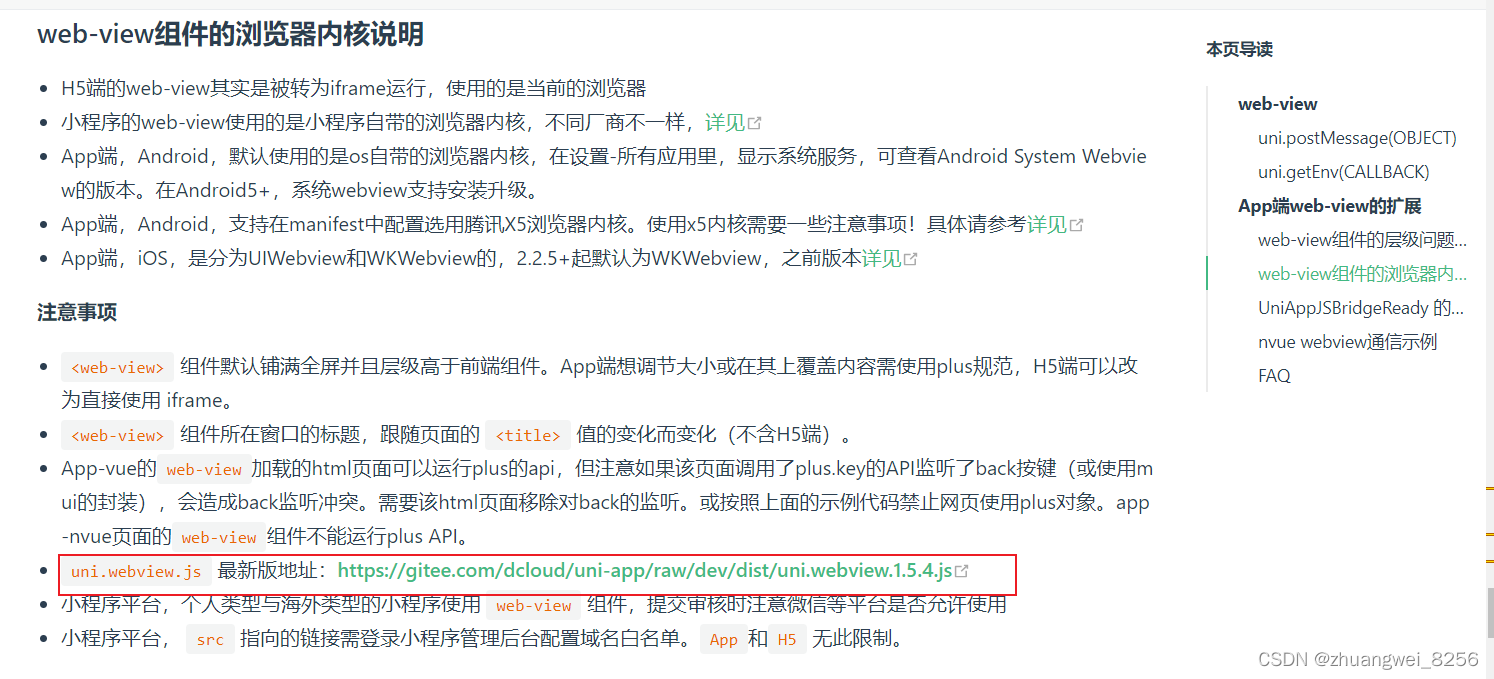Table of contents
APP side:
<web-view :webview-styles="webviewStyles" :src="src" @message="handleByH5"></web-view>
data() {
return {
wv: null,
src: '',
webviewStyles: {
progress: {
color: '#43ACFF'
}
},
isCanBack: true, // 是否允许手机物理返回
}
}
Quote
app passes parameters to H5: pass parameters through h5 address
This method is simple, just pass the src address directly and then pass ? &the splicing parameters.
- app side
onLoad() {
this.src = 'https://editor.csdn.net/md?articleId=130581348'
}
onLoadThe h5 end receives parameters through the uniapp life cycle function
onLoad({
articleId }) {
// .....
}
app passes parameters to H5: evalJSpass parameters through methods
H5 passes parameters to the app: through web-viewcomponent @messagebinding method
Handling the physical return problem of mobile phones in H5 pages
Here, and are written
app给H5传参:通过方法evalJS传参together to facilitate viewing the communication interaction between the app and H5.H5给app传参:通过web-view 组件的@message绑定的方法处理H5页面的手机物理返回问题
See code for details
- app side
onBackPress(options) {
// 这里return true禁用手机的物理返回,避免H5页面使用返回的时候也调用app的手机物理返回
// return false 允许手机的物理返回
if (options.from == 'backbutton') {
return this.isCanBack
}
},
onLoad() {
// #ifdef APP-PLUS
this.$showLoading('正在努力加载中,请稍候……')
let currentWebview = this.$scope.$getAppWebview() //此对象相当于html5plus里的plus.webview.currentWebview()。在uni-app里vue页面直接使用plus.webview.currentWebview()无效
setTimeout(() => {
let wv = currentWebview.children()[0]
this.wv = wv
this.wv.setStyle({
bottom: 0
})
// 处理web-view h5页面的手机物理返回问题
plus.key.addEventListener('backbutton', () => {
// 监听返回事件
wv.canBack((e) => {
if (e.canBack) {
this.isCanBack = true
wv.back() // 返回上一页
} else {
// wv.close(); // 关闭嵌入的H5应用
this.isCanBack = false
}
})
})
this.$hideLoading()
}, 1000) // 注意这里跳转过去的都是相当于是一级页面,所以需要延迟一下,如果报xxx is not undefined,则是因为对应的页面还没有加载出来,相应的xxx 方法就没有挂载上去
// #endif
},
methods: {
// 监听 H5 发送过来的消息,也就是webView.postMessage过来的信息
handleByH5(data) {
console.log('监听H5的操作 ----index------ data', data)
const {
pageBack } = data.detail.data[0]
switch (action) {
case 'pageBack':
pageBack()
break
case 'getLocation':
// 获取位置
this.getCurrentLocation()
break
}
},
// 获取当前位置信息
async getCurrentLocation() {
const res = await getLocation()
console.log('获取当前位置信息----', res)
if (res && !res.errMsg) {
const {
longitude, latitude, address } = res
let locationInfo = {
longitude,
latitude,
location: address.poiName
}
// 将结果返回给H5页面,evalJS触发H5中绑定在window上的方法getLocationByApp,达到传参的目的
this.wv.evalJS(`getLocationByApp('${
JSON.stringify(locationInfo)}')`)
} else {
// 将结果返回给H5页面
this.wv.evalJS(`getLocationByApp('${
JSON.stringify(false)}')`)
}
},
}
Quote
- Extension of App-side web-view : The relevant api official websites mentioned above are all explained.
- evalJS : Execute JS script in Webview window
- The h5 side
defines awebviewUtil.jsfile and puts all methods of communicating with the app in it to facilitate maintenance.

webviewUtil.js
import $this from '@/main'
// $this vue实例,在main.js中已经将vue实例抛出
/**
* 调用app的获取定位信息
*/
export const getLocationByApp = (callback) => {
// 这一步是向APP传参,APP中通过web-view的@message绑定的handleByH5方法接收对应的参数
$this.$myUni.webView.postMessage({
data: {
action: "getLocation",
},
});
window.getLocationByApp = (res) => {
let result = JSON.parse(res);
callback && callback(result)
}
setTimeout(() => {
let defaultLocationInfo = {
longitude: 115.995196,
latitude: 28.675518,
location: '南昌市'
}
callback && callback(defaultLocationInfo)
}, 1000)
}
main.js
import Vue from 'vue'
import App from './App'
// 需要使用到uni.webview.js的一些方法
import * as uniWebView from '@/common/uni_webview.js'
document.addEventListener('UniAppJSBridgeReady', () => {
// 将uniWebView赋值给vue原型,方便调用
Vue.prototype.$myUni = uniWebView
});
Vue.config.productionTip = false
App.mpType = 'app'
const app = new Vue({
...App
})
app.$mount()
// 将vue 实例抛出,方便某些js文件中调用vue api
export default app;
You need to download uni-webview.js to call some methods of webview
webviewUtil.jsFinally, the encapsulated method is called in the corresponding page.
export const getCurrLocation = () => {
return new Promise((resolve) => {
getLocationByApp((locationInfo) => {
if (!locationInfo) {
let defaultLocationInfo = {
longitude: 115.995196,
latitude: 28.675518,
location: '南昌市'
}
resolve(defaultLocationInfo)
return
}
resolve(locationInfo)
})
})
}
Summarize:
- app communicates to h5
- Parameters can be passed through
webviewcomponent-bound address splicing parameters;src - You can also
evalJScall H5-side bound methods through methodswindow.xxxand pass parameters through methods;
- Parameters can be passed through
- h5 passes parameters to app
- Pass parameters through the downloaded
uni.webview.jsfile call and receive parameters through the binding method of the component.webView.postMessageAPPweb-view@message
- Pass parameters through the downloaded
